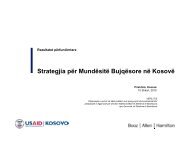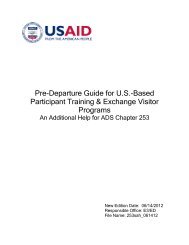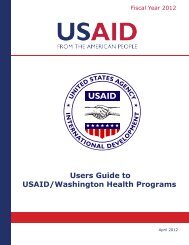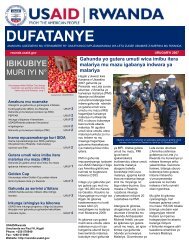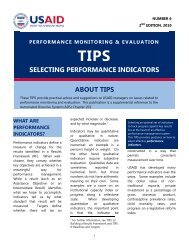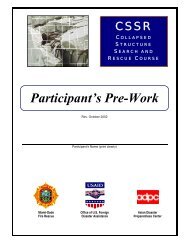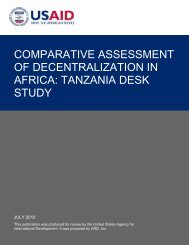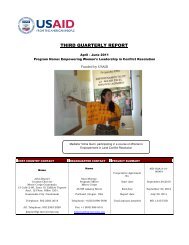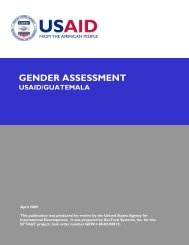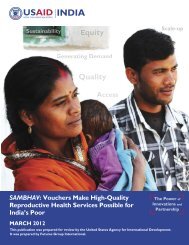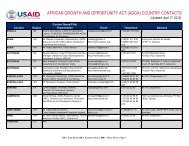DCA Russia Impact Brief - USAID.gov
DCA Russia Impact Brief - USAID.gov
DCA Russia Impact Brief - USAID.gov
You also want an ePaper? Increase the reach of your titles
YUMPU automatically turns print PDFs into web optimized ePapers that Google loves.
<strong>DCA</strong> LOAN GUARANTEE<br />
RUSSIA<br />
IMPACT BRIEF
On the Cover: The city of Rostov-on-Don<br />
BACKGROUND<br />
In 2003, small and medium enterprises (SMEs) in<br />
<strong>Russia</strong> accounted for 94 percent of the total number<br />
of businesses in the country. However, despite their<br />
numbers, SMEs produced only 13 percent of GDP in<br />
2004 and commercial<br />
ABOUT <strong>DCA</strong><br />
credit available to help<br />
<strong>USAID</strong>'s Development Credit Authority<br />
(<strong>DCA</strong>) was created in 1999 to mobilize SMEs grow met only one<br />
local private capital through the percent of demand. High<br />
establishment of real risk sharing transaction costs,<br />
relationships with private financial<br />
perceived riskiness of<br />
institutions in <strong>USAID</strong> countries. The tool<br />
is available to all <strong>USAID</strong> overseas commercial lending to<br />
missions and can be used as a vehicle SMEs, lack of sound risk<br />
for providing much needed credit to an assessment methodology,<br />
array of enterprises and underserved and unfavorable<br />
sectors. The evaluation in <strong>Russia</strong> is part<br />
regulations <strong>gov</strong>erning<br />
of a set of evaluations that EGAT/DC is<br />
undertaking in different countries, to test collateral possession in<br />
a series of developmental hypotheses case of default<br />
related to the <strong>DCA</strong> guarantees. discouraged banks from<br />
lending to SMEs. SMEs<br />
that wanted to borrow did not have sufficient<br />
collateral to meet bank requirements and faced<br />
burdensome interest rates.<br />
<strong>USAID</strong> responded to the lack of SME finance in 2004<br />
by providing a $6 million, 5-year loan portfolio<br />
guarantee (LPG) to a regional Southern Federal<br />
District (SFD) bank, Bank Center-Invest. <strong>USAID</strong> had<br />
discovered that Center-Invest was planning to expand<br />
its SME lending to other oblasts in the SFD and<br />
agreed to support the bank with an LPG under the<br />
Agency’s Development Credit Authority (<strong>DCA</strong>). The<br />
program proposed to cover 50 percent of Center-<br />
Invest’s principal losses on a portfolio of loans made<br />
to SMEs through its new branches in Krasnodar and<br />
Volgograd, with the objective of providing credit to<br />
SMEs who would not otherwise have access to formal<br />
financial markets.<br />
CENTER-INVEST <strong>DCA</strong> LOAN GUARANTEE<br />
Starting<br />
Year<br />
Ending<br />
Year<br />
Ceiling<br />
Amount<br />
($)<br />
Number of<br />
Loans (as of<br />
6/2009)<br />
Aggregate<br />
Amount ($)<br />
EVALUATION OBJECTIVES<br />
<strong>USAID</strong>’s Office of Development Credit (EGAT/DC),<br />
which administers the <strong>DCA</strong> guarantees,<br />
commissioned an evaluation of the Center-Invest<br />
guarantee in 2009. This evaluation assesses the<br />
performance of the guarantee relative to its objectives<br />
as defined in the Action Package developed by<br />
<strong>USAID</strong>/<strong>Russia</strong>, i.e., increasing access to credit for<br />
SMEs in Rostov, Krasnodar, and Volgograd. The<br />
evaluation assesses the outputs, outcomes, and<br />
impacts of the guarantee.<br />
The evaluation covers Center-Invest’s lending<br />
behavior and potential demonstration effects in the<br />
banking sector. It does not examine EGAT/DC’s or<br />
<strong>USAID</strong>/<strong>Russia</strong>’s administration of the guarantee, nor<br />
does it examine the guarantee’s contribution to<br />
<strong>USAID</strong>/<strong>Russia</strong>’s strategic objectives.<br />
EVALUATION METHODOLOGY<br />
This evaluation used a mixed methods approach,<br />
including statistical analysis of loan data, key informant<br />
and group interviews, and document review. It began<br />
with a review of background documents on Center-<br />
Invest and its <strong>DCA</strong> guarantee, and continued in <strong>Russia</strong><br />
from June 15-26 with semi-structured interviews with<br />
Center-Invest staff and clients, the <strong>USAID</strong> Mission,<br />
and other financial sector experts. The lead evaluator<br />
used comparative analysis, statistical analysis, and<br />
content pattern analysis to draw findings from the<br />
collected data, from which she drew conclusions.<br />
Data limitations included: (1) unavailability of and nonresponse<br />
from several Center-Invest staff members;<br />
(2) lack of data on Center-Invest’s non-guaranteed<br />
lending; and (3) no interviews with recipients of<br />
guaranteed loans. However, the evaluator does not<br />
believe these limitations significantly impact the<br />
evaluation conclusions.<br />
Utilization<br />
Rate<br />
Median<br />
Loan Size<br />
($)<br />
Average Loan<br />
Tenor<br />
(months)<br />
2004 2009 6 million 137 4,570,886 76.18 % 17,809 9
KEY FINDINGS AND CONCLUSIONS<br />
OUTPUTS<br />
Conclusions The <strong>DCA</strong> guarantee purpose—to expand<br />
lending to Krasnodar and Volgograd—fit perfectly<br />
within Center-Invest’s business strategy. However, due<br />
to its risk aversion and the challenging SME<br />
environments in Krasnodar and Volgograd, the bank<br />
decided it was not ready to lend to these markets right<br />
away and therefore used most of the guarantee funds to<br />
loan to collateral-poor SMEs in the Rostov region.<br />
Center-Invest’s lending portfolio has performed well<br />
since the <strong>DCA</strong> guarantee began. The guarantee’s<br />
influence on Center-Invest’s portfolio characteristics<br />
was minimal, simply because the guaranteed loans<br />
represented a small proportion of the Bank’s SME<br />
portfolio and the bank made no procedural changes to<br />
accommodate the guarantee.<br />
Findings in support of these conclusions include:<br />
• The Purpose of the signed Guarantee Agreement<br />
between <strong>USAID</strong> and Center-Invest was “To<br />
strengthen the Guaranteed Party’s ability to<br />
expand its SME loan portfolio through its newly<br />
opened branches in two <strong>Russia</strong>n regions:<br />
Krasnodar and Volgograd….” This purpose is<br />
consistent with Center-Invest’s objective for the<br />
guarantee: developing relationships with clients in<br />
Krasnodar and Volgograd, which was also part of<br />
Center-Invest’s 2003-2008 business plan.<br />
• Center-Invest provided eight of its 137 <strong>DCA</strong><br />
guaranteed loans to businesses in the Krasnodar<br />
region and five in Volgograd.<br />
• Center-Invest’s Head of the SME Lending<br />
Department explained that the bank had not<br />
scrutinized the markets in Krasnodar and<br />
Volgograd prior to receiving the <strong>DCA</strong> guarantee<br />
and was hesitant to risk lending to unknown<br />
markets. By the time Center-Invest felt more<br />
comfortable lending in Krasnodar and Volgograd, it<br />
had already come to within 76 percent of the<br />
maximum portfolio amount allowed under the<br />
guarantee.<br />
• Representatives of Center-Invest and the European<br />
Bank for Reconstruction and Development (EBRD)<br />
in Rostov said that since the SME sector in<br />
Krasnodar and Volgograd does not receive much<br />
<strong>gov</strong>ernment support, the environment is less<br />
conducive for SME lending.<br />
• Center-Invest principals said the bank used its<br />
standard processes to assess the creditworthiness<br />
of SMEs and to calculate the collateral requirement<br />
for each loan. In cases in which otherwise solid<br />
businesses could not meet the collateral<br />
requirement, Center-Invest made loans under the<br />
<strong>DCA</strong> guarantee.<br />
• Center-Invest’s average collateral requirement is<br />
150 percent of the value of the loan. The average<br />
collateral percentage among <strong>DCA</strong> guaranteed loans<br />
was 111 percent.<br />
• The value of Center-Invest’s SME portfolio<br />
increased from RUR 3,206 million in 2003 to RUR<br />
10,045 million in 2008, a 213 percent growth.<br />
• Together, the total value of the <strong>DCA</strong> guaranteed<br />
loans represented one percent of Center-Invest’s<br />
SME portfolio value as of January 1, 2009.<br />
OUTCOMES<br />
Conclusions The <strong>DCA</strong> guarantee has contributed to<br />
increased credit access for Center-Invest’s borrowers<br />
and may have influenced the bank to participate in other<br />
guarantee funds. The full impact of the guarantee on<br />
Center-Invest’s non-guaranteed lending business is<br />
larger than the one percent it directly contributed to<br />
the bank’s growth, but we do not have sufficient data to<br />
make a reasonably accurate estimate.<br />
Findings to support these conclusions include:<br />
• Center-Invest’s Head of SME Lending explained<br />
that clients who received <strong>DCA</strong> guaranteed loans<br />
would not likely have become clients without the<br />
guarantee, because they could not meet the<br />
collateral requirements. The bank retained all but<br />
three or four of these clients.<br />
• The bank intends to participate in an upcoming<br />
tender from the Rostov regional <strong>gov</strong>ernment for a<br />
guarantee fund that backs loans to SMEs short of<br />
collateral. The bank also signed an agreement with<br />
the Regional Guarantee Fund of Volgograd for<br />
guaranteeing loans to SMEs lacking collateral.<br />
• Center-Invest expanded its credit product<br />
offerings for SMEs between 2003 and 2009 from
fewer than six identifiable loan products to 13.<br />
The Head of SME Lending at Center-Invest said<br />
that the <strong>DCA</strong> guarantee inspired the bank to<br />
extend its credit product line.<br />
• Center-Invest is now the largest provider of SME<br />
loans in the Rostov region in terms of volume,<br />
overtaking the previously dominant, state-owned<br />
Sberbank.<br />
• Since clients who received a guaranteed loan<br />
received additional loans from the bank, the<br />
multiplier effect pushes the guarantee’s direct<br />
one percent contribution to the bank’s loan<br />
portfolio higher, but there is insufficient data to<br />
estimate the multiplier value.<br />
• Reasons given for Center-Invest’s success in the<br />
Rostov region SME market include: effective public<br />
relations, ties with the local administration and<br />
international partners, and an unwavering focus on the<br />
needs of regional SMEs, along with strong community<br />
ties.<br />
SME Portfolio value (million<br />
RUR)<br />
IMPACTS<br />
Conclusions Other banks have increased lending to SMEs<br />
since 2004, especially in the SFD, because of a combination<br />
of favorable economic and infrastructure conditions that<br />
fueled SME development, <strong>gov</strong>ernment programs encouraging<br />
lending to SMEs, and experience with SMEs as profitable<br />
customers. However, SMEs’ access to credit has not<br />
significantly improved. Center-Invest seems to be unique in<br />
its concerted efforts to make financing accessible to small<br />
businesses in the SFD, and it has significantly improved the<br />
environment for SME lending.<br />
Findings to support these conclusions include:<br />
• All interviewees, including Center-Invest clients, agreed<br />
that banks have increased lending to SMEs in <strong>Russia</strong> in<br />
general and in Rostov specifically since 2003 because:<br />
(1) banks expected SME lending to grow; (2) SME loans<br />
provide good yields; (3) the <strong>Russia</strong>n economy was<br />
growing rapidly; (4) there was unmet demand for SME<br />
credit; (5) banks found that SMEs were reliable<br />
borrowers; (6) the regional Rostov administration<br />
supported SMEs through subsidies; and (7) the<br />
favorable economy in Rostov attracted more SMEs,<br />
CENTER-INVEST BANK SME LOAN PORTFOLIO<br />
20,000<br />
18,000<br />
16,000<br />
14,000<br />
12,000<br />
10,000<br />
8,000<br />
6,000<br />
4,000<br />
2,000<br />
0<br />
CONTACT INFORMATION<br />
U.S. Agency for International Development<br />
Office of Development Credit<br />
1300 Pennsylvania Avenue, NW<br />
Washington, D.C. 20523<br />
http://www.<strong>USAID</strong>.<strong>gov</strong><br />
Keyword: <strong>DCA</strong><br />
2001 2002 2003 2004 2005 2006 2007 2008<br />
which attracted banks to lend to them.<br />
• SMEs said that it is still very difficult to obtain finance in<br />
Rostov and collateral requirements can be as high as<br />
400 percent. The EBRD said that banks still see<br />
crediting SMEs as risky and therefore do not offer<br />
terms that are favorable to SMEs, or treat SMEs as<br />
corporate clients, with documentation, accounting, and<br />
collateral requirements that are too high for SMEs to<br />
attain.<br />
• Since its founding, Center-Invest has supported SMEs<br />
through a variety of charitable and financial projects.<br />
Center-Invest has been providing free legal advice to<br />
clients via a hotline since 2006. With funding from the<br />
IFC, the bank introduced an energy efficiency program<br />
in 2005, which finances projects that reduce companies’<br />
operating costs and promote a greener economy.<br />
• In 2006, the bank hosted its second international<br />
conference, “<strong>Russia</strong>n and German Day for SME<br />
financing,” in which it connected its SME customers<br />
with entrepreneurs and financiers in Germany. The<br />
bank recently hosted a workshop to instruct SMEs on<br />
how to obtain <strong>gov</strong>ernment contracts, to which it<br />
invited both SME clients and <strong>gov</strong>ernment officials.<br />
This publication was produced for review by the United States Agency for<br />
International Development. It was prepared by SEGURA/IP3 Partners LLC under<br />
SEGIR Global Business, Trade and Investment II – IQC Indefinite Quantity Contract,<br />
Number EEM-I-00-07-00001-00 Task Order # 04, Development Credit Authority<br />
Evaluation.



